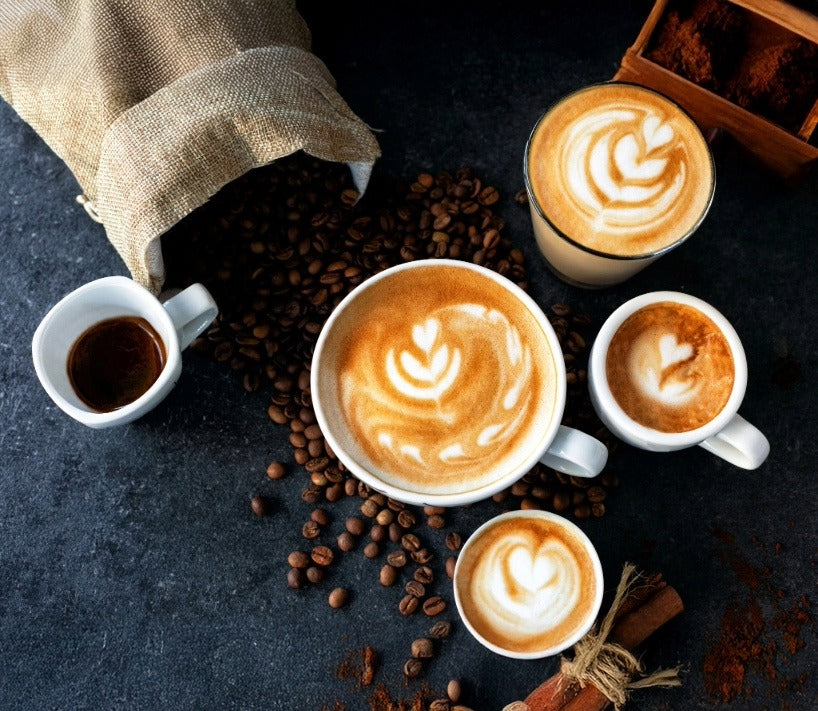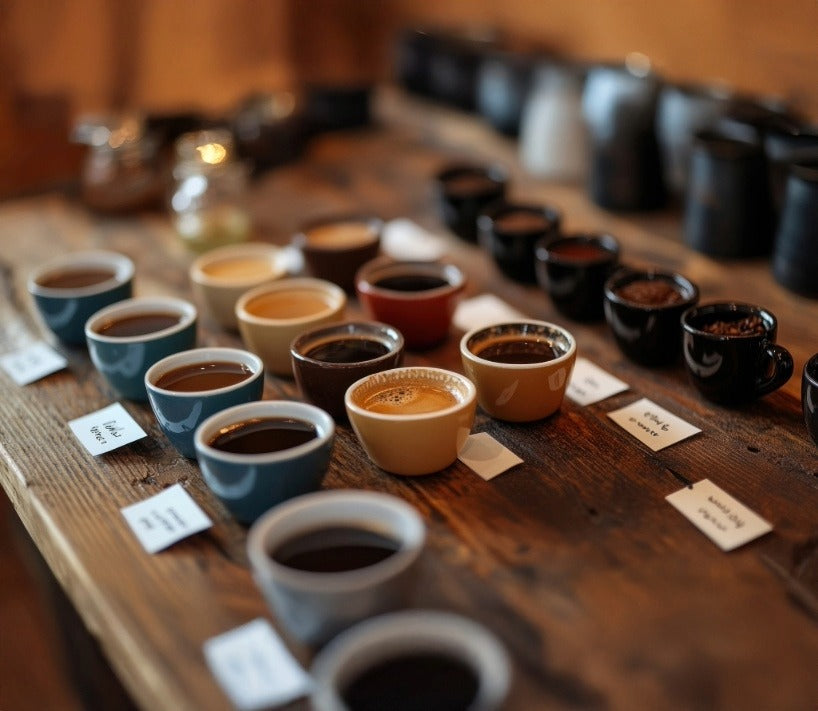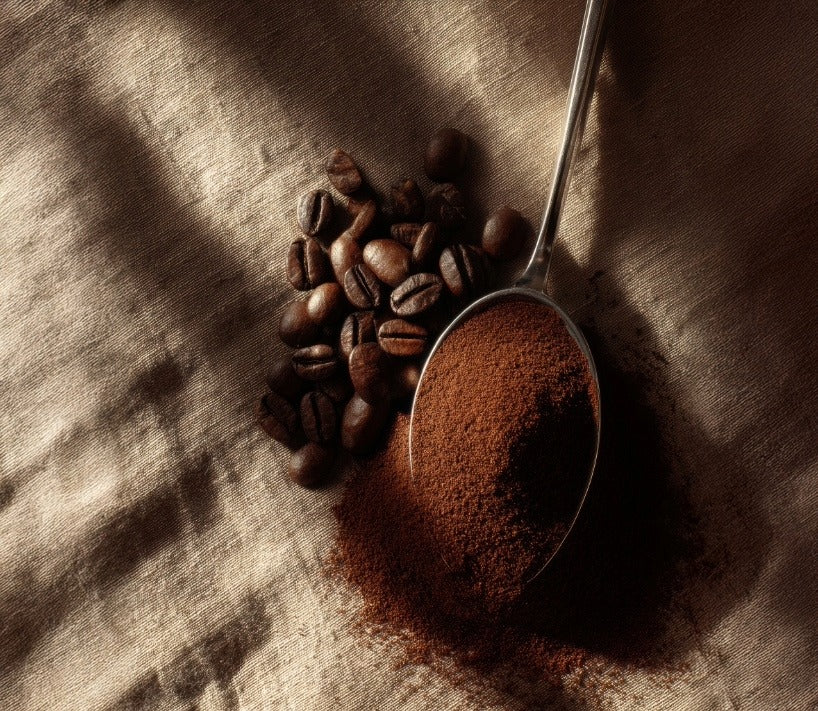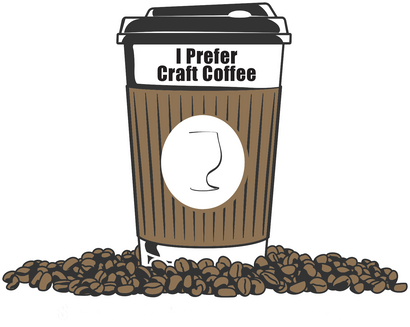Swiss-Water Sorcery: How I Turned a Peruvian Decaf Into Your New Favorite Cup
April 28, 2025 5 min read
Swiss-Water Sorcery: How I Turned a Peruvian Decaf Into Your New Favorite Cup
“Wait, That’s Decaf?”
If you’d told twenty-year-old me that I’d someday rave about a decaf coffee, I’d have laughed hard enough to aerosolize espresso. Fast-forward to today—older, wiser, and limited to two cups of fully leaded joe before noon—and here I am, hand-roasting an organic, Swiss Water–processed Peruvian coffee for my buddy Joshua. (Yes, that Joshua—New Jersey’s premier small-business food reviewer who can spot stale biscotti from three counties away.)
I brewed him a cup, waited for the verdict, and basked in a glorious pause followed by:
“Dude … no way this isn’t full-caf.”
Mission accomplished. If you’ve been scanning Google for the best coffee online or muttering “where can I buy fresh coffee beans near me?”—but you need (or simply want) to limit caffeine—stick around. We’re about to demystify why Swiss Water decaf can taste like the best small batch coffee you’ve ever tried, while its evil twin—Ethyl Acetate (EA) decaf—often tastes like cardboard dipped in regret.
The Bean to Cup Breakdown (a.k.a. Why Joshua’s Cup Slaps)
I’m breaking this middle section into five bite-size chapters so you can jump straight to whatever keeps you up at night—figuratively, of course, because this coffee won’t.
1. Why Peruvian Beans Deserve Their Own Fan Club
Peru’s high-altitude farms (think 1,600 – 2,000 m) grow beans slowly, which concentrates sugars and those elusive floral-cocoa vibes we coffee nerds chase. When folks ask me for the best craft coffee online that’s also gentle enough to be a good coffee to drink black, Peru is my go-to answer.
Bonus nerd tidbit: these beans score 85+ on the Q-grading scale. That makes them “excellent” in the specialty world—just a hair shy of the 90-plus unicorns auctioned for house-down-payment prices.
2. Swiss Water vs. Ethyl Acetate: Cage Match
-
Swiss Water: Uses osmosis and activated carbon to remove 99.9 % of caffeine. No chemicals. Retains origin flavor.
-
EA Process: Uses a naturally occurring solvent (often from fermented sugarcane) to bond with caffeine. “Natural,” yes—but extended exposure plus additional rinses can strip aromatics faster than you can say best espresso beans.
Translation? Swiss Water beans still smell like chocolate-covered orange peel; many EA decafs smell like the cardboard box your top coffee delivered arrived in.
3. Roasting Decaf Is Not for the Faint of Heart
Unroasted decaf beans are the color of pistachios and as brittle as dried leaves. Crack the temperature too high, and they char; too low, and you get grassy sadness. For Joshua’s batch, I stretched the Maillard phase (the point where sugars caramelize) just enough to coax butterscotch notes without sacrificing the bergamot twang.
Tips if you roast at home:
-
Lower Charge Temp: Start the drum ~20 °C cooler than you would for regular beans.
-
Gentle Mid-Roast Ramp: Decaf releases moisture fast; slow your heat input around first crack.
-
Shorter Development: Aim for 12–13 % development time ratio. Overdo it, and the cup turns flat.
4. Brewing for Maximum “Wait, That’s Decaf?” Shock Value
Whether you’re a French-press devotee or chasing the best espresso beans for your countertop machine, dialing in decaf is a game of nuance:
-
Grind Slightly Finer than your typical full-caf recipe; decaf beans are less dense.
-
Lower Water Temp a smidge (195 – 198 °F) to dodge bitter tannins.
-
Bloom Longer (40–45 sec) because CO₂ degasses slower in decaf.
Run these tweaks, and even your friend who claims decaf is “brown sadness water” may ask for seconds.
5. Storing Your Hard-Won Beans
Freshness isn’t just for full-caf. Keep your decaf tasting like the best tasting whole bean coffee by:
-
Using a One-Way Valve Bag (keeps O₂ out, lets CO₂ exit).
-
Stashing in a Dark Cabinet (sunlight = flavor vampire).
-
Freezing Small Portions only if you won’t finish the bag within three weeks; thaw sealed to avoid condensation.
Follow these, and that coffee beans as a gift package you ship cross-country will survive the journey with flavor intact—a win for presents for coffee lovers everywhere.
What You Get Out of All This (Besides Bragging Rights)
So you stuck with me through the geekery. What’s in it for you? Three very practical takeaways, no gimmicks, no “Add to Cart” button.
-
Confidence to Navigate Decaf Labels
Next time a bag screams “Premium Sugarcane EA Decaf,” you’ll know EA can equal flavor light-years behind Swiss Water. You’ll gravitate toward the process that preserves taste—whether you buy specialty coffee online or pick up a bag at that “specialty coffee near me” roaster. -
A Blueprint for Brewing Flavor-First Decaf
From charge temps to bloom times, you’ve got the cliff notes. Apply them and your morning mug will hold its own against any café’s full-caf latte—heck, even the best coffee for non coffee drinkers curious about mellow, low-acid thrills. -
A Conversation Starter That Makes You the Resident Coffee Sage
Imagine sliding a cup across the table, announcing, “This is decaf,” and watching eyes widen. It’s the adult equivalent of a card trick—except tastier, and you can parlay it into chat about sustainable farming, organic certifications, or why best specialty coffee online isn’t always about caffeine content.
10 Quick-Hit FAQs (Because Google Loves These)
-
Is Swiss Water decaf completely caffeine-free?
Technically 99.9 %—you’d need eight cups to equal one full-caf’s caffeine. -
Does decaf go stale slower?
Nope. Flavor compounds degrade at the same pace as regular coffee. -
Best grind size for decaf espresso?
One click finer than your usual shot to compensate for density loss. -
Can I use decaf in cold brew?
Absolutely; try a 1:5 ratio steeped 16 hr for dessert-like sweetness. -
Is EA decaf unsafe?
It’s FDA-approved, but many drinkers notice muted flavor. -
Why Peru for decaf?
High altitude + organic farming = complexity that survives decaf processing. -
What roast level is ideal?
City+ to Full City; dark roasts can bury delicate notes. -
Do darker roasts have less caffeine even before decaf?
Slightly, yes, but the difference is marginal. -
Best water temp for pourover decaf?
195 °F to maintain sweetness without extracting harshness. -
Any tipping-point age for decaf beans?
Flavor nose-dives after 30 days post-roast. Buy small and often.
Final Sip
If you're looking for the best decaf coffee online that doesn't skip a beat on flavor, this Peruvian organic SWP decaf is one of the best decaf coffees I’ve ever tasted. It proves two things:
-
Chemical-free decaf doesn’t have to taste like disappointment.
-
With a little know-how, we can all brew the best craft coffee at home—caffeine optional.
If you’re still spinning from the sea of online options—top coffee delivered! “best craft coffee online!”—feel free to drop me a line. I’m always down to chat beans, roast curves, or which best espresso beans pair with a late-night slice of tiramisu (spoiler: this Peruvian decaf is shockingly good).
Until then, may your mugs be warm, your beans be fresh, and your decaf forever fool the skeptics. Cheers!
Also in Best Coffee To Buy Online Education

Best Specialty Coffee Explained: Why It Tastes So Much Better
December 20, 2025 5 min read
Learn why the best tasting specialty coffee at home tastes sweeter, cleaner, and better — and how to pick the best beans for home brewing. Taste the difference when you order coffee online through I Prefer Craft Coffee.

What Makes Specialty Coffee Taste Better: The Real Reason
December 19, 2025 4 min read
I’ve also roasted thousands of pounds of air roasted coffee beans, shipped fresh roasted coffee beans online, and helped tons of people upgrade from “meh” to “HOLY FLAVOR” with tiny changes.

How To Choose Specialty Coffee Beans the Easy Way
December 18, 2025 4 min read
Fresh roasted coffee beans online should tell you when the beans were roasted… not when the bag expires in 2028.
